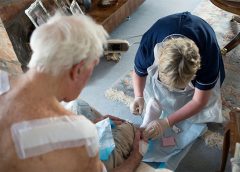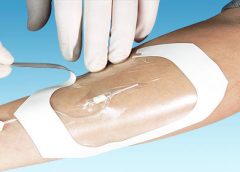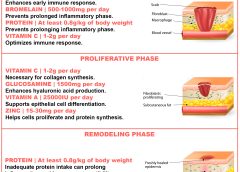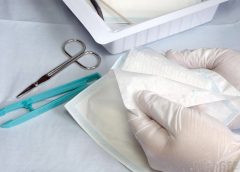Search Results for: w
World Wide Pressure Ulcer Prevention Day – November 21, 2013
How do you prove a wound was unavoidable?
By Jeri Lundgren, BSN, RN, PHN, CWS, CWCN
A pressure ulcer that a patient acquires in your facility or a patient’s existing pressure ulcer that worsens puts your organization at risk for regulatory citations as well as litigation. Unless you can prove the pressure ulcer was unavoidable, you could find yourself burdened with citations or fines, or could even end up in court. (more…)
Read MoreWhat you need to know about hydrogel dressings
By Nancy Morgan, RN, BSN, MBA, WOC, WCC, DWC, OMS
Each issue, Apple Bites brings you a tool you can apply in your daily practice.
Description
Hydrated polymer (hydrogel) dressings, originally developed in the 1950s, contain 90% water in a gel base, which helps regulate fluid exchange from the wound surface. Hydrogel dressing are usually clear or translucent and vary in viscosity or thickness. They’re available in three forms: (more…)
Read MoreSkin problems with chronic venous insufficiency and phlebolymphedema
Dermatologic difficulties: Skin problems in patients with chronic venous insufficiency and phlebolymphedema By Nancy Chatham, RN, MSN, ANP-BC, CWOCN, CWS; Lori Thomas, MS, OTR/L, CLT-LANA; and Michael Molyneaux, MD
Skin problems associated with chronic venous insufficiency (CVI) and phlebolymphedema are common and often difficult to treat. The CVI cycle of skin and soft tissue injury from chronic disease processes can be unrelenting. If not properly identified and treated, these skin problems can impede the prompt treatment of lymphedema and reduce a patient’s quality of life.
This article reviews skin problems that occur in patients with CVI and phlebolymphedema and discusses the importance of using a multidisciplinary team approach to manage these patients. (more…)
Read MoreHow dietary protein intake promotes wound healing
By Nancy Collins, PhD, RD, LD/N, FAPWCA, and Allison Schnitzer
Nutrition is a critical factor in the wound healing process, with adequate protein intake essential to the successful healing of a wound. Patients with both chronic and acute wounds, such as postsurgical wounds or pressure ulcers, require an increased amount of protein to ensure complete and timely healing of their wounds.
Elderly patients with wounds pose a special challenge because of their decreased lean body mass and the likelihood of chronic illnesses and insufficient dietary protein intake. To promote a full recovery, wound care clinicians must address the increased protein needs of wound patients, especially elderly patients. (more…)
Read MoreWound Management Technologies Receives Additional Funding from Brookhaven Medical Inc.; Expands Executive Team
Scientists Discover Important Wound-Healing Process
Dealing with difficult people
By Rose O. Sherman, EdD, RN, NEA-BC, FAAN
Unfortunately, most clinicians can’t avoid having to work with difficult people. However we can learn how to be more effective in these situations, keeping in mind that learning to work with difficult people is both an art and a science.
How difficult people differ from the rest of us
We can all be difficult at times, but some people are difficult more often. They demonstrate such behaviors as arguing a point over and over, choosing their own self-interest over what’s best for the team, talking rather than listening, and showing disrespect. These behaviors can become habits. In most cases, difficult people have received feedback about their behavior at some time, but they haven’t made a consistent change. (See Is she a bully or a difficult person? by clicking the PDf icon above) (more…)
Read MoreHow to fit in fast at your new job
By Gregory S. Kopp, RN, MN, MHA
A new job can be stimulating, but it can also be stressful. Not only will you have new responsibilities, but you’ll also have a new setting, new leaders, and new colleagues. And the quicker you can figure out who’s who and what’s what—without stepping on anyone’s toes—the better off you’ll be.
But establishing positive relationships while performing your new job well can be tricky. And early missteps can have a lasting effect on your working relationships and your effectiveness. That’s why I recommend using the four tactics below, starting on day one. (more…)
Read MoreWhat you need to know about collagen wound dressings
By Nancy Morgan, RN, BSN, MBA, WOC, WCC, DWC, OMS
Description
Collagen, the protein that gives the skin its tensile strength, plays a key role
in each phase of wound healing. It attracts cells, such as fibroblasts and keratinocytes, to the wound, which encourages debridement, angiogenesis, and reepithelialization. In addition, collagen provides a natural scaffold or substrate for new tissue growth. (more…)
Improving outcomes with noncontact low-frequency ultrasound
By Ronnel Alumia, BSN, RN, WCC, CWCN, OMS
Achieving excellent wound care outcomes can be challenging, given the growing number of high-risk patients admitted to healthcare facilities today. Many of these patients have comorbidities, such as obesity, diabetes, renal disease, smoking, chronic obstructive pulmonary disease, and poor nutritional status. These conditions reduce wound-healing ability. (more…)
Read More



